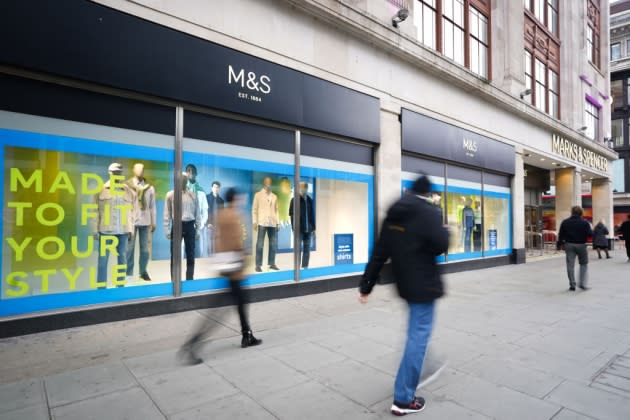Marks & Spencer Is Making a Name for Itself in Denim

British department store retailer Marks & Spencer (M&S) reported rising revenue and profits for the year that ended April 1 as it shows improvement in the business of clothing and home goods.
In a Nutshell: M&S said sparing customers from the impact of rising inflation by keeping prices intact was the right move, CEO Stuart Machin said, even if doing so ate into margins.
More from Sourcing Journal
“Sales were up in store and online, supported by growth in Click and Collect sales, active App users and Sparks loyalty membership, demonstrating the emerging power of our omni-channel model,” he said.
Machin, who took over from former CEO Steve Rowe a year ago, and co-CEO Katie Bickerstaffe plan for clothing and home to grow their market share by 1 percent in the next five years. They aim to do so by growing the omnichannel business, M&S private labels and the company’s 140-plus partner brands. Eighty-eight percent of inventory sold through at full price for the full year, similar to previous rates. Clothing and footwear market share rose to 9.3 percent.
Women’s denim sales rose 13 percent from less than 10 percent two years ago. Casual dress sales were up 40 percent. M&S bought deeper into popular lines to meet strong demand, using short lead-time supply routes while managing markdown risk.
In men’s, premium Autograph collection sales rose 60 percent. Chino sales were up 25 percent. M&S said this was due to “smart separates” for work. Sales of kids’ and home products were just okay.
Marks & Spencer plans to open eight full-line stores in the new fiscal year. It plans to cut back on selling floor space for clothing and home goods by 20 percent. The chain, which operates 180 full-line stores, will close 20 doors and relocate 10, including five new flagships in Liverpool, Leeds, Manchester, Birmingham and Thurrock.
M&S has worked on using fewer, more strategic clothing and fabric suppliers. Last year it decided to get out of Myanmar because of human-rights risks.
GlobalData’s senior retail analyst Eleanor Simpson-Gould said that while “broadening choice through the inclusion of third party brands is a positive step,” M&S must maintain its investment in existing price points to distinguish from competitors John Lewis and Next. As it focuses on ramping up omni-channel capabilities, “care must be taken not to alienate customers who prefer human interaction at the checkout,” she said.
New Sales: Total revenues were up 9.9 percent to 11.99 billion pounds ($14.85 billion) from 10.91 billion pounds ($13.51 billion). Clothing and home sales rose 11.5 percent to 3.72 billion pounds ($4.61 billion). Store sales rose 14.9 percent and online grew 4.8 percent. M&S reported strong growth—up 20 percent—in its Click & Collect sales, with more than one-third of orders now generated through the M&S app.
Despite shipping delays over the holiday, customer orders grew 12.6 percent. Three-quarters of online returns are processed in M&S stores. Upgrades to the online experience include “one click” checkout with digital receipts. Digital Click and Collect is being rolled out to stores to enable rapid collection and self-service returns, both aimed at reducing processing costs and faster turnaround time for resale.
International sales rose 11.2 percent to 1.06 billion pounds ($1.31 billion) on a constant currency basis, with partner retail sales up 8 percent driven by clothing and home categories. M&S said its objective is to grow international retail sales through leveraging its brand through capital light partnerships and a multi-platform online business with global reach. It will open a logistics hub in Croatia to facilitate fulfillment in European Union markets.
On an adjusted operating profit basis, clothing and home was 323.8 million pounds ($401.1 million) for the year. That compares with 330.7 million pounds ($428 million) a year ago, which includes 35.2 million pounds ($45.6 million) in rates relief.
Earnings: Pre-tax profits rose 21.4 percent to 475.7 million pounds ($589.3 million) from 391.7 million pounds ($485.2 million).
Profit before tax and adjusting items was 482.0 million pounds ($597.1 million). That compares with 522.9 million pounds ($676.7 million) a year ago, including 59.8 million pounds ($77.4 million) in U.K. business rates relief and a net rates charge of 139.7 million pounds ($180.8 million) compared with a net rates charge of 186.6 million pounds ($231.2 million) in the current year ended.
“While the economic outlook for consumer spending is uncertain, cost inflation remains high, and market conditions are expected to become more challenging, the strategy is beginning to deliver improved performance,” M&S said.
M&S expects modest growth in revenues for Fiscal Year 2024, driven by omnichannel and the acceleration of its store growth plan. Cost inflation estimates include over 50 million pounds ($61.9 million) related to energy costs and over 100 million pounds ($123.9 million) connected to pay increase. The costs will be offset by its structural cost reduction program, expected to provide over 150 million pounds ($185.8 million) in projected savings planned for the year.
CEO’s Take: “M&S is such a special business with so much potential,” Machin said. “Despite facing significant headwinds, I am encouraged by the strong foundations established last year and excited about what we can achieve in the year ahead.”
Solve the daily Crossword

